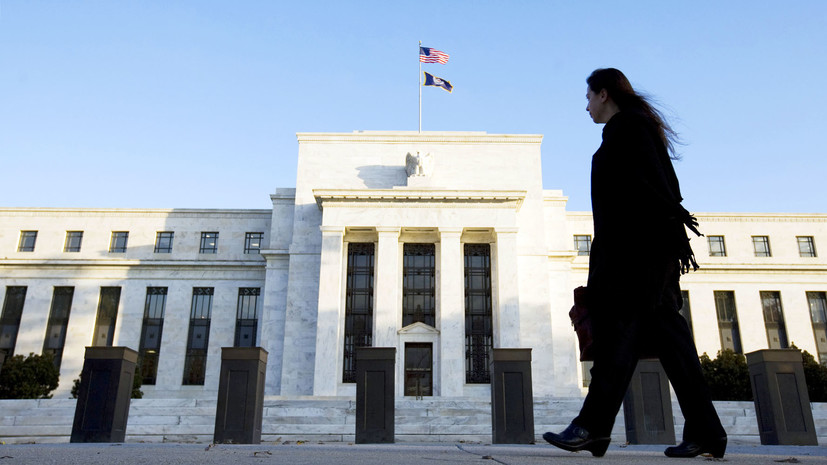The US Federal Reserve lowered its base rate from 1-1.25% to 0-0.25% per annum. The top management of the American regulator made this decision as part of the fight against the growing threat of the coronavirus pandemic for the economy.
“The effects of coronavirus will have an impact on economic activity in the short term, and this poses a threat to economic prospects. In the light of this development, the committee decided to reduce the target range of the federal funds rate to 0-0.25%, ”the Federal Reserve Open Market Committee said in a statement.
Note, according to recent estimates, the total number of coronavirus infected in the world is approaching 170 thousand, of which more than 6.5 thousand have died. Most infected were registered in China (about 81 thousand), Italy (about 25 thousand), Iran (14 thousand), South Korea (more than 8.2 thousand), Spain (7.7 thousand) and France ( 5.9 thousand).
The spread of the disease has already provoked a massive reduction in the volume of trade and passenger traffic in the world, and also caused a record drop in stock markets. Against this background, experts do not rule out the onset of a new global recession in 2020.
“Since medicine cannot stop the coronavirus so far, the Fed is urgently introducing a financial vaccine. The regulator reduces its lending rate so that cheaper loans stimulate investments in production, increase demand and reduce the burden on loans. Reducing the cost of borrowing makes equity investments more attractive, which is designed to help the stock market, ”explained TeleTrade chief analyst Mark Goichmann.
Recall the last time the US Federal Reserve lowered its rate to 0-0.25% per annum during the global financial crisis of 2008. This measure was taken to stimulate economic growth during the recession: loans became cheaper, and the level of consumption and investment began to grow.
The US central bank has taken the interest rate increase course only since December 2015. This policy tightening was adopted to protect the economy from overheating. Rising rates traditionally increase the cost of borrowing for American business and somewhat weaken the overall economic activity in the country.
Meanwhile, signs of a new economic slowdown forced the Fed to stop tightening its policy. As a result, amid fears of another recession, from August 2019 the Fed again headed for a rate cut.
Pumping money
In addition to a record rate cut, the Fed also announced a shift to a quantitative easing policy. The regulator plans to additionally purchase bonds worth $ 700 billion.
Recall, the Fed actively pursued a policy of quantitative easing after the start of the 2008 crisis. To stimulate the national economy, the regulator “turned on the printing press” and bought up securities on the issued money. As a result, from 2008 to 2015, the value of acquired assets on the Fed’s balance sheet increased from $ 8.9 billion to $ 4.5 trillion. Such data are presented on the official website of the regulator.
In 2017, the Fed announced a quantitative tightening program and began selling assets from its balance sheet. By September 2019, the amount of securities available to the Fed dropped to $ 3.7 trillion. However, from the beginning of autumn, the regulator again began to buy bonds. To date, the volume of assets on the balance sheet of the regulator has already reached $ 4.3 trillion and may soon grow to $ 5 trillion.
“By buying bonds, the Fed pours money into the financial system. Such actions should support financial stability in the period of uncertainty, ”Vyacheslav Abramov, director of the BCS Broker sales office, told RT.
At the same time, the Federal Reserve also agreed with five central banks (Bank of Canada, Bank of England, Bank of Japan, ECB and Swiss National Bank) to simplify the process of mutual granting of loans to each other through the so-called currency swaps.
“Central banks have agreed to lower the rate of existing swap lines in US dollars by 25 basis points,” the regulators said in a distributed joint message.
According to the terms of the swap contracts, countries buy currency from each other and after a certain time sell back at a fixed rate. Such operations allow regulators to avoid cash shortages.
“In the event that stressful situations arise with a lack of funds from credit institutions of the listed countries, they will be able to quickly provide each other with dollars to maintain stability,” Abramov added.
Nervous reaction
Although the decision of the US Federal Reserve was to reassure global investors and support stock markets, on March 16, trading on international exchanges was accompanied by a massive collapse of quotations. As a result of the Asian session, the indicator of the Shanghai SSE Composite Exchange fell 3.4%, and the Japanese Nikkei - 2.46%. At the same time, during trading on European markets, the French CAC 40 index decreased by 8.25%, the English FTSE 100 - by 6%, and the German DAX index - by 7%.
“In general, the Fed’s decision to inject liquidity was not encouraging, but scared the markets. Investors took this information as recognition of the beginning of a recession in the global economy, ”said Artyom Deev, head of the AMarkets analytical department, in an interview with RT.
However, according to analysts, over time the Fed will still be able to support the global financial system and weaken the impact of the spread of COVID-19 on the global economy. However, the policy of the regulator may weaken the position of the dollar.
“The US Federal Reserve supports the global financial system with a quantitative easing program and a rate cut. Such measures weaken the national currency, but should reduce the negative effect of the consequences of the coronavirus pandemic, ”concluded Vyacheslav Abramov.

